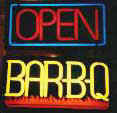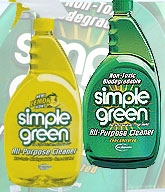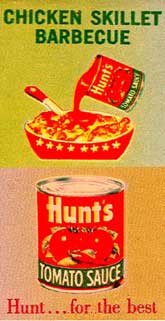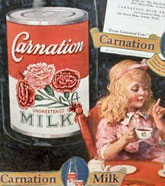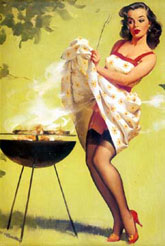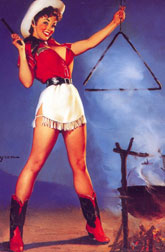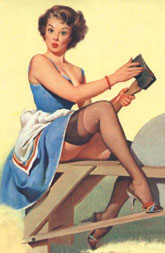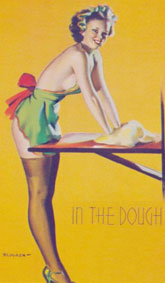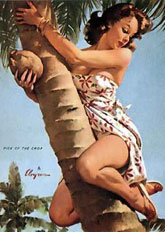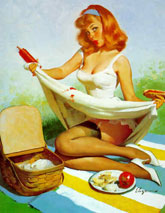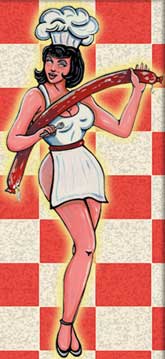Contact BBQbyDan
www.BBQDan.com
Search
KCBS BBQ Cook-Off Info
Recipes,
Smoking Meats
Recipes, Grilling
|
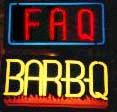 |
FAQ OF THE INTERNET BBQ LIST Version 2.0 Section 17 Problems While Barbecuing--What Went Wrong? |
--------------------
[What is the best way to learn how to barbecue?]
Put the engineering books away. This is cooking meat here. There is far more art than science, more alchemy than chemistry. Get some wood, matches, and meat and go to it. You will learn far more by building a fire and watching the results than anyone here can teach you. There is no instruction book on making good barbecue.
--------------------
[Will the smoke preserve my food?]
There are two types of smoking, cold and hot. Cold smoking is a method of preserving meat. First the meat or fish is soaked in a brine solution, then smoked cold at temperatures of 100F or so. Bacon is done this way. Hot smoking is really smoke cooking. It is done at temperatures in the 225F range and will not add any preservation to the foods. This FAQ is devoted to smoke cooking.
--------------------
[What meats are used?]
Beef briskets are favored in Texas, pork shoulders in North Carolina, ribs in Kansas, chicken in Louisiana. Much of the regional favoritism is due to the type of animals raised in the area. Turkey, seafood, lamb, goat and venison can also be smoked in this manner.
--------------------
[Why cook the meat so long?]
Barbecue is an evolution of cooking technique that involves using the tough, cheaper cuts of meat and cooking them until they are tender. Brisket comes from the breast area of a steer that does a lot of work and tends to be very tough. This is also true for pork shoulders (the forelegs of the pig). These cuts of meat have a lot of fat and collagen, the material that holds the muscle together. Long slow cooking transforms the collagen from a tough material to a gelatin that dissolves. This can take hours at a temperature of about 160F.
--------------------
[What is a rub?]
Often meats are seasoned before cooking by application of a dry rub. It is a blend of spices and herbs rubbed onto the meat to enhance flavor. There are many variations. Most recipes include: salt, paprika, chili powder, garlic and onion powders, black and red peppers. There is no limit to the imaginative use of spice combinations.
-------------------
[What is this 'Mr. Brown' I read about?]
The brown crust that forms on the outside of the barbecued meat is referred to by some barbecuers as 'Mr. Brown'. This dark tasty layer is also called 'the crust'. There is also a commercial dry rub with the trade name of "Mr. Brown". It is available at barbecue specialty stores.
--------------------
[What's the best kind of smoker for me to buy and what will it cost?]
You can spend as little as $30 for a bullet water smoker or tens of thousands of dollars for a custom-built rig. Most of us spend less than $500. Keep in mind that equipment is only part of the story. A good pit-master can turn out good barbecue on simple homemade units costing a few dollars. Starting out, consider the Brinkmann Cook'N Cajun Charcoal Smoker or similar unit at around $50, or an off-set firebox smoker that runs about $200. Once you have mastered those, you will know better what suits your needs.
--------------------
[Are all smokers wood-fired? Can I use my gas grill to barbecue?]
It is the wood that is used to generate the smoke. That is the common denominator of all barbecue pits. For a heat source, some use charcoal, wood, gas, wood pellets, even electricity. Traditionalists use wood as a fuel, but many of the newer units work well with charcoal. A gas or electric smoker with wood chips for the smoke can do a very good job of making barbecue and be much less labor intensive in keeping the fire at a steady temperature.
The common backyard gas grills are not air tight enough to do proper smoking, but you can still get some flavor by using the wood chips in a pan over the lava rock. Use one burner and keep it as low as possible and put the meat on the other side of the grill, elevated if you have a top rack.
--------------------
[I've seen some inexpensive bullet water smokers. Are these smokers any good?]
There are two main types of barbecue smokers, horizontal and vertical. The horizontal smokers usually have a firebox off-set to the side to provide the heat and smoke. I highly recommend the vertical water smokers to the beginner, especially if you are not sure if this is the way of life for you. They are very capable cookers and can turn out prize-winning food.
There are three basic types of vertical water smokers, segregated by the fuel they use: wood or charcoal, gas, or electricity. All can give the beginner very good barbecue.
Vertical smokers are more compact and can be cheaper to build. A good example is the $30 Brinkmann Sportsman Smoker, the better $50 Brinkmann Cook N' Cajun and The H2O Smoker from Char-Broil. Weber makes the best charcoal bullet smoker, The Smoky Mountain Cooker, around $170 . What they have in common is a water pan. This is what differentiates the smoking process over indirect heat from grilling over direct heat. The water pan is a buffer between the heat source and the meat. It also acts as a heat sink and thermal mass, lessening the temperature spikes often seen while adding fuel to the fire.
The original Brinkmann had two pans, one for water, one with a hole in it for the charcoal. Due to someone burning down his deck, they no longer provide the hole in the bottom pan. This restricts the airflow and makes it more difficult to use. See Section 7.2.1 for information on how to modify your bullet smoker to make it work more efficiently and to give you better barbecue.
--------------------
[Can you help me get started on my first time with a water smoker?]
Start the coals with a chimney starter and let them burn until a white ash covers the coals. Put the water pan in place. To make clean-up easier, spray it with Pam first and put in a foil liner. Pour in some hot water. I suggest hot (almost boiling) because it will get the food cooking faster instead of wasting the heat output to bring the water up to temperature. To add water during the cooking session, use a long-nose water can or similar item. Open the door, not the lid, and pour. If you are using an electric or gas-fired water smoker, lift the dome lid and pour the water past the meat into the lower water pan. DO BE CAREFUL WHEN YOU MOVE OR POUR HOT WATER, AS SERIOUS INJURY CAN RESULT FROM UNSAFE HANDLING. FOLLOW THE MANUFACTURER'S SAFETY GUIDELINES FOR YOUR SMOKER.
It is best to pre-start coals if you must add more than a few. This can be done in a bucket or other pan. Use tongs to transfer the coals to the smoker. If the temperature drops, give the coals a stir with a metal rod. Re-bar and old Studebaker lug wrenches work well for this job.
After you use the smoker a few times, you can experiment. Instead of water, leave the pan empty, but cover it with foil, much as if you were making it into a drum. You will still have the buffer, but the smoker will now operate at a higher temperature. If you have a hole in the center, or place an aluminum pan on the top, it will still catch the drippings from the meat.
You may want to add a more accurate thermometer to your smoker to supplement or replace the simple thermometer that came installed in the dome of your smoker. Most important is knowing your smoker. Note the needle position of the factory gauge and the actual number will not matter; after a few tries, you will know if the temperature is running too hot or too cold. The end result is what counts.
Resist the temptation to peek. You release a lot of heat and smoke every time you lift the lid. You can use wood chips, pellets, or chunks to get the smoke you want. Just put them on top of the burning coals, the gas plate or on/near the electric element. Chunks should be soaked in water for an hour or two before hand so they do not burn up too fast. It only takes a few chunks to turn out good smoked food. You want a light white smoke, not a dense white smoke. More here is not better.
--------------------
[How do I maintain an even temperature inside the smoker?]
Regulate the amount of fuel in the fire. Dampening down the burning wood can make the fire smolder and make a heavy, bitter smoke. It is better to use less fuel burning at a high temperature, rather than a lot of fuel burning at a low temperature. If the temperature gets too high, open the door to release the heat. Short temperature spikes and drops are normal and will not affect the end result.
There are two approaches here. One is the Lazy-Q way, letting an electric or gas-fired system make your life easy. The other way is to have a traditional wood-burning smoker. The Lazy-Q'ers are often at odds with the wood purists. Have to say though, the wood burners work harder and develop more skills to make good barbecue. It is more challenging, both mentally and physically to keep a fire in a narrow, low temperature range for a long period of time.
You have to learn to think ahead, not for what the thermometer says now. You have to anticipate. Using a baseball analogy, the batter starts his swing long before the ball is over the plate. He has to figure out where it is going to be and has to be there to meet it. Same with wood; you have to know how long the coals will be hot, how long for the next log to catch, what the wind will be doing, what effect the sun or lack of it will have on the smoker. What works at 2 p.m. in the afternoon is not going to work at 2 a.m. the next morning when that brisket is still going.
The sun affects the heat of the smoker. On a 90F day, you have a differential of 135F from optimum cooking temperature. Later that night, you have a 175F differential. At night you'll have no heat absorption of the sun's heat, and a slight breeze may carry off lots of BTUs from the surface of the smoker and you'll have a stronger draft in the flue.
--------------------
[What's the best kind of wood to burn and do the different kinds of smoking woods 'taste' different?]
The southwest uses a lot of mesquite, the south uses mostly hickory, the northeast has maple. The main reason is because these woods are plentiful in those areas. Any wood from a nut or fruit bearing tree can be used. Do NOT use any softwood. The resin in conifer wood (pine, fir, spruce, etc.) will ruin the meat and can make you very sick. There is more information regarding woods for smoking in Section 8.
--------------------
[Can you make good barbecue with briquettes and what's the difference between lump charcoal and charcoal briquettes?]
Charcoal is made by burning wood in very low oxygen levels. This leaves mostly carbon. In this form, it is known as natural or lump charcoal. It will be of irregularly-shaped pieces of broken-up wood. If you shake the bag, it sounds like the tinkle of broken glass. Briquettes are different. The charcoal is ground into a powder and then additives are introduced. The additives can include starches, coal dust, oil products and other binders. Under high pressure, the ground charcoal and additives are formed to the regular shapes that are familiar to us. The advantage touted by the manufacturers of briquettes is the consistency of the product in heat output and burn rates. Lump charcoal has a higher BTU rating per pound and is preferred by many barbecuers. Never use the easy-light type charcoals for slow cooking. They have additives that must be burned off at high heat and if used in a smoker will give your barbecued meat nasty flavors.
--------------------
[My door mounted thermometer read 220F the whole time but it took a lot longer than I expected for the meat to get done. Why is this?]
The thermometer on the door is giving you the temperature at the door. Cooking temperatures are defined as the temperature at the rack where the food is. All smokers have hot and cold spots as well as temperature stratification. Heat rises so the readings at the top can be 50 or more degrees F hotter than at the rack. Use an oven thermometer on the rack to find the difference in your smoker. Keep in mind, the temperature can vary depending to how the smoker is loaded with meat, so you will want to try this several times. Once the difference is known, you can make the adjustment by knowing that you have to keep the door thermometer at a certain temperature so the meat cooks at 225F or so.
--------------------
[What is a smoke ring?]
Smoke rings are produced by a chemical reaction between the meat and the penetration of the smoke. You will see a smoke ring on meat barbecued over a wood fire. It is a pink color that extends from the outside surface into the meat. It's thickness is dependent on several factors, such as the type of smoke and the duration of smoking. See the following two questions for a better understanding of the chemical reactions involved.
--------------------
[Why is my barbecued chicken pink? Is it still raw?]
No, the smoke has a reaction with the chemicals in the bone and meat. The meat turns a pink color even though it is thoroughly cooked. Ash is loaded with potassium and sodium nitrates. This reacts with oxymethyglobin to form nitrosaminoglobulins and gives us the pink color of hams, lunch meats, hot dogs, and smoke rings.
Man has known this for a long time and has been using salt to preserve meat. It was found that nitrates are a natural impurity in salt. This was isolated and used to chemically cure meat. (Saltpeter)
--------------------
[When do you use a dry rub and a marinade?]
Much depends on your personal choice. A marinade can flavor and moisten the meat. A rub only adds flavor. Many barbecuers use a marinade followed by a dry rub.
--------------------
[Can you give me a few recipes for dry rubs?]
Dry rubs contain some salt along with other spices. Many have sugar in them to take the bite out of the spices. Experiment to find what you like.
Danny Gaulden's Sparerib Rub
Amount |
Measure |
Ingredient |
Preparation Method |
1 |
tablespoon | granulated garlic | |
1 |
tablespoon | onion powder | |
2 |
tablespoons | salt | |
1 |
tablespoon | cayenne pepper | |
1 |
tablespoon | black pepper | |
1 |
tablespoon | white pepper | |
1/2 |
cup | paprika | |
1 |
cup | brown sugar |
This may be a little hot for some folks, so one may want to reduce the cayenne a little, but that's the way they like'em out West. I believe the brown sugar is a must, and when it caramelizes, it produces that rich dark cherry-red color, plus it tastes good!
=================Dry Rub for Poultry
Amount |
Measure |
Ingredient |
Preparation Method |
6 |
tablespoons | salt | |
3 |
tablespoons | black pepper | |
2 |
tablespoons | pepper powder | |
2 |
tablespoons | garlic powder | |
2 |
tablespoons | ground bay leaves | |
1 |
tablespoon | paprika | |
2 |
tablespoons | dry mustard |
Sprinkle this on chicken and turkey before barbecuing.
--------------------[Can you give us a recipe for a simple marinade?]
A simple marinade is 8 ounces each of cider vinegar and lemon juice, two ounces of Tabasco sauce and a few cloves of crushed garlic. You can use beer and onions or you can use Dr. Pepper or Coke, or all four together. Another simple marinade is to just combine orange juice or apple juice with beer.
There are many dry rub and marinade recipes in the BBQ List recipe archive.
--------------------[When do I apply the barbecue sauce?]
Finishing sauces, especially those with tomato and sugar, should be applied only at the very end of cooking. If applied too early, they will caramelize, burn and turn black from the heat.
--------------------[What's a mop and when do I use it?]
Mops are basting sauces used to add moisture during the cooking process. They usually contain liquids that can take the heat with no ill affects. They consist of one or more of: beer, wine, beef broth, fruit juices, vegetable oil and some spices. Apply them about every hour during cooking.
--------------------[How do I barbecue really good tasting and tender pork ribs?]
Everybody likes ribs, especially baby backs. On the bone side of the rib there is a membrane. From one corner, cut under it with a knife and work the it up with your fingers. Pull it off working toward the other side. You can marinate them or you can put a rub on them. Remember, ribs are thin so you do not want to pile on the rub like you would a large piece of meat. Just a light coating on each side will do.
Fire up the smoker and get it up to a temperature of 225-240F at the grill. If you put them on flat, place them fat side up. If you want to save space, use a rib rack to stand them on end or you can roll them up loosely and hold them together with a bamboo skewer. Smoke baby backs for about 3-4 hours, spares for about 4-5 hours. You will see the meat pulling back on the bone when they are done. Use a carving fork and poke it between the ribs. When the ribs are done, the fork will go in easy. Serve with a little sauce on the side. Opinions vary, but the meat should be the star, not the sauce. Sauces are to accent the taste of the meat.
--------------------[How do I barbecue North Carolina-style pulled pork?]
True NC pulled pork is a pork shoulder smoked over hickory coals. You can use either the picnic half or the butt half as it is difficult to find whole shoulders. Each half will weigh about 7 to 8 pounds. Smoke gently (220-240F at meat-grill level) until the meat is very tender. This takes from 8 to 12 hours, keeping the meat at or above 160F. The meat should be ready to fall apart at an internal temperature of 185-190F. Pull or chop the meat, putting it into a container. Eastern NC style uses a sauce consisting of cider vinegar, salt, black pepper, and red pepper. Variations include sugar to off-set the vinegar. About 12 ounces of sauce to 6 pounds of finished meat. Mix this together, refrigerate overnight so the flavors meld together and serve on white bread buns, perhaps with coleslaw on the top.
--------------------[Can I smoke bacon at home?]
Yes, it is a cold smoking and curing process. An excellent description is on Rick
Thead's page for meat preserving. It describes the brining process, gives the cure recipe
and the smoking process. ![]() Click here
Click here
[Is it really possible to get good barbecue from an inexpensive water smoker?
Frank Boyer--
There is a gentleman named Harold F. from Oregon who has ten or so Brinkmann water smokers, and he often uses up to four units to compete with. He has won the Oregon state championship, as well as taking first in ribs (open) and brisket (invitational) at the 1994 American Royal Barbecue Championship in Kansas City. The invitational is all-state, comprised of champions or winners of previous cook-offs. There are over 50 cooks competing and the cook-off is KCBS sanctioned. If you learn to use your water smoker, world class results can follow.
The RE Max team at the KCBS of 1995 uses 2 or 3 Weber water smokers and has won many events. The Weber units cost about $170 and are the highest quality of all of the water smokers, and they have the best air controls.
--------------------[Can I make good barbecue on a gas or electric smoker using chips of wood?]
Danny Gaulden--
I just want to say this. Sometimes we old pros and perfectionists get so carried away with the long, slow, wood-only, "perfect" Q'ed product, that I think we get some of the beginners thinking that if they can't do it that way, then just don't barbecue anything. That's horse hockey. If you have the time, and gain the experience, then do it the old-fashioned way--it can't be beat. But if time is short, your experience level low, or you're just plain lazy, there's nothing wrong with a little faster smoking time, or using a gas or electric smoker. It can still be darn good, and better than most anything you will ever put in your mouth.
--------------------[Can you help me make some good barbecue on my gas grill? Any good recipes? And can you make barbecue as good as what comes off a wood-fired smoker?]
Danny Gaulden--
Your "any good recipes to try on my gas grill?" couldn't have been more timely. As a matter of fact, it might be the best way to get started to some excellent barbecuing, for learning to build and maintain the proper wood or charcoal fire, keeping the heat and smoke correct, etc. can be a school of learning in its own right, and is a little overwhelming for a lot of beginners. Sometimes they get discouraged and give up--we don't want that to happen with you. With the gas grill, you can concentrate more on the meat, play with the smoke, have a few cold ones, and the odds with the gas grill will be more in your favor to produce some good stuff the first few times around than with a wood burner. Is it "as good as what comes off a wood fired smoker"? Not in my opinion, but it's next to it, and better than anything you will ever cook in the kitchen oven, and that's a pretty good start. And it will have that great outdoor flavor.
While at my cabin recently, I carried a few things to barbecue, and one of the items was a pork Boston butt. I have a little smoker up there, along with a smaller, cheaper gas grill. I intended to smoke the butt on the smoker with charcoal and wood chunks, and didn't take any charcoal, for I thought I had a 20 lb. bag of it up there. Guess what--no charcoal, and the nearest store was about 25 miles down the mountain. So I elected to use the gas grill. It is a two burner with left and right control knobs. I rubbed the butt with some of Willingham's dry rub, let it sit awhile at room temperature (it's cool up there), fired up the left side of the grill on the lowest setting it would go, and put the butt on the right side for an indirect smoking process. The temperature next to the meat stayed at about 250 to 275F, but no burning of the fat cap, or meat occurred. I threw some wet hickory wood chunks (no foil, just raw chunks) onto the lava rock fired side every time one would burn out. I did not use a mop. I cooked the butt with the fat side up for about 4 or 5 hours, then turned it over with the fat side down. About every hour, I would turn the meat with a different side to the fire so it would cook more evenly. After 8 hours, it was very fork tender through and through, and was a beautiful color. I basted it with my mustard, vinegar and brown sugar glaze a couple of times during the last half hour of smoking. This really turned out great, and was a lot of pure fun to do without a lot of hassle. It did take a lot of attention during the entire cooking time, but I had nothing else to do, and enjoyed it. It had a really nice smoke flavor, as I kept a little smoke on it almost constantly.
If you have a Weber Genesis grill, you should be able to achieve a more even heat distribution than I did with my cheap grill, so get to barbecuing, and make some good stuff.
--------------------[Can someone help me with some basic questions about using an electric bullet type water smoker?]
Glenn Birkhimer--
OK. Fire away with the questions.
--------------------[Will an oven thermometer sitting on the rack show an accurate temperature?]
Glenn--
I use an oven thermometer on the bottom rack where I can see it when I open the side door. One problem with putting a thermometer in the smoker, is that after awhile smoke will most likely get under the cover and it will become unreadable. Environmental conditions can affect the lower grill temperature as measured by my oven thermometer. During hot (90+F) and no wind days, I've observed 260F at the lower grill level and 265F in the dome. I drilled a 1/4" hole in the dome near the handle to hold a cheap metal candy thermometer. If it's windy the grill temperature is usually somewhere between 235F and 250F depending on air temperature. The dome temperature is very sensitive to wind. With no wind it can get over 265F. Breezy wind and it has trouble staying above 220F. I now use a funky old cardboard box about 2 ft. square and slightly taller than the smoker as a wind break on breezy days and during cooler weather. On a recent smoking session in November the air temperature was 54F and breezy at 2:00 p.m. and dropped to 46F by 5:00 p.m.. With the windbreak in place, my lower grill temperature stayed at 250F once the smoker was heated up to temperature. The dome temperature varied between 220F and 240F.
--------------------[Where in the smoker do I put the chips?]
Glenn--
I use water-soaked hickory chunks, either right on the lava rock or in a little steel pan set on the heating element. Forget the foil log stuff. My chunks catch on fire if they touch the element, so I don't let them do it. Flaming chunks generate too much heat and flying ashes.
==============Bill Wight--
I have a Char-Broil electric smoker (1650 watts). The best method I've found to date is to put three or four 1" x 2" chunks of mesquite, hickory or pecan right on top of or touching the electric element. The chunks slowly burn for almost two hours and this gives a nice, steady, light-white to invisible smoke and the best tasting end results. As the chunks burn, I turn them over or move them closer to the heating element every 60 minutes or so. You want a light to invisible smoke, not a heavy dense smoke.
I have not seen a smoke ring in any of the meat I have smoked in my electric water smoker, no matter what wood chunks I use.
==============Rock McNelly--
If the electric bullet is not set up right, it can be difficult to get it up to temperature. The things that effect it the most are:
1 Light-weight extension cords. -- Use at least a 12 gauge wire cord. Buy at a hardware store or make one up yourself.
2 Too many lava rocks to heat up. -- Get rid of them and line the bottom with foil. No lava rocks or ceramic briquettes are needed.
3 Way too much water in the pan. -- Use about 2 liters of boiling water.
4 Excessive lifting of the lid. -- don't peek. Lift the lid only when necessary to mop, not peek.
5 Too much heat escapes around the lid. -- Fill gaps with foil. Make new vents in top of lid that you can open and shut.
--------------------[What goal should I aim for in my barbecue? How good is good enough?]
M. Baudoin--
I've made ribs that make grown men fight and chicken that has made women faint.
(Editor-- Sounds like a pretty fair goal to me.)
--End of Mini-FAQ--
-
Return to the Table of Contents
Return to the BBQ FAQ Home Page
Comments or Suggestions
BBQ FAQ Ver 2.0 ©1997, 1998 William W. Wight. All rights reserved.

